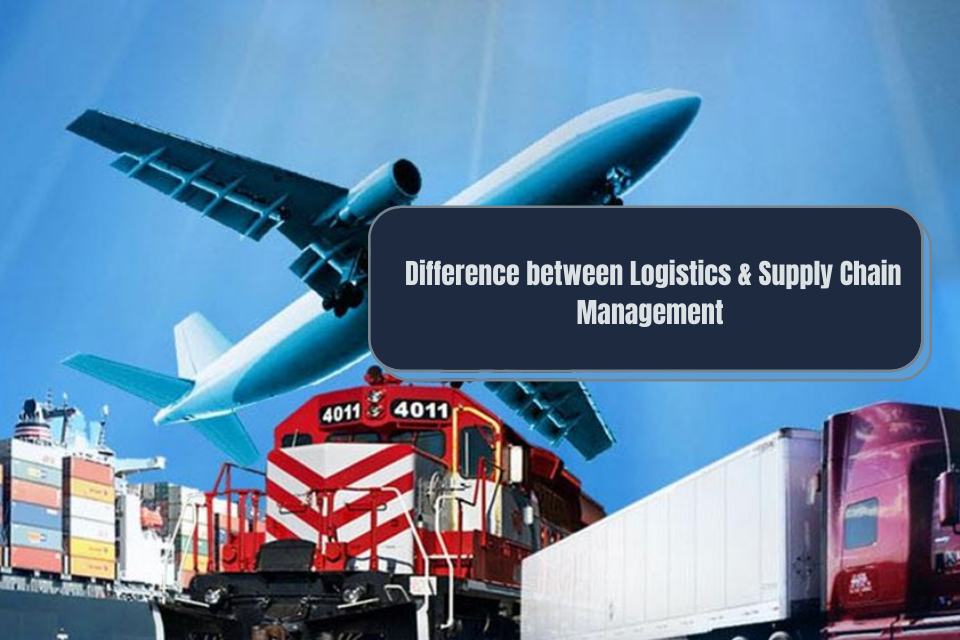Although supply chain management and logistics have many parallels, there is a difference between logistics and supply chains. Recognizing every function could assist businesses to improve procedures, improve consumer relations, and achieve a competitive edge.
Logistics is concerned with the internal flow of commodities, whereas supply chain management is concerned with operations involving independent companies.
Despite certain similarities among these two systems, they are distinct constructs with distinct connotations. Logistics relates to the transportation, warehousing, and transfer of commodities, services, and communication inside the broader supply chain, whereas supply chain management is an encompassing process that includes all different operations to generate market edge.
Defining Supply Chain Management
The action that produces final commodities and distributes those to consumers is referred to as supply chain management. SCM additionally concentrates on streamlining supply chain procedures for the convenience of consumers and business associates.
If an organization maintains transparency over its supply chain, it will only maximize and continuously refine SCM. This transparency allows businesses to monitor commodities and services that progress through the supply chain, making it far simpler to watch whether everything is functioning as expected. It moreover provides an additional chance for decision-makers to adjust to distractions or other barriers.
SCM entails managing a wide array of sub-suppliers (such as raw material suppliers), distributors, producers, logistics operators, distribution companies, dealers, and end consumers. The supply chain’s numerous partners have a variety of practices. Relationships can be straight, including between components and resources providers, producers and merchants, or horizontal, such as when a corporation unites with or obtains a related business that works around a similar supply chain phase.
What Exactly Is Logistics?
Organizing and implementing the preservation and transit of items among various stages in the supply chain is part of logistics. Logistics integrates infrastructures, persons, technology, as well as other assets to guarantee that goods arrive at their destination on time and in good condition. Logistics encompasses order processing, shipping (such as fleet management), inventory control, warehouse management, and delivery of products.
A company’s financial position might be harmed by improper logistics. Weak logistics result in late delivery, inability to satisfy customer requirements, and, as a result, the firm suffers. The word “logistics” is becoming widely popular in the business sector, particularly among factories, to characterize how goods are handled and moved throughout the supply chain.
To minimize expenses and maximize productivity, an effective supply chain and fine logistical operations are required. To fulfill the need for faster, better efficient delivery of a greater selection of items, suppliers, producers, marketers, and retailers have had to upgrade their logistics procedures. All of the components require the aspect of information and control to operate as catalysts for numerous operating processes.
Differentiating Logistics and Supply Chain Management
The policy and operations which go with planning, procuring, manufacturing, and distributing items, and also handling returns, are covered in supply chain management.
Logistics is concerned with getting the right items to the correct spot at the right time and figuring out how to get them there. As should be obvious at around this time, supply chain management and logistics overlap however they are distinct in terms of extent and concentration. The following are the main difference between logistics and supply chain:
- Supply chain management operations include logistics. Production and inventory planning, workforce planning, equipment and supplies management, producing and distributing products and services are all covered under Supply Chain Management.
- Supply Chain Management focuses on refining processes to gain a competitive edge, whereas logistics focuses on satisfying consumer demands and preferences.
- The goal of logistics is to deliver items to clients in a timely and cost-friendly manner.
- The conversion of raw resources into final products that flow from the provider to the manufacturer to the warehouse to merchants and/or customers is regulated by supply chain management.
- Logistics is a phrase that has been around for a great many years, originating in the military, although supply chain management is a newer one.
- Logistics is managed by a single company, while Supply Chain Management is done by many companies.
Consumer requirements are fulfilled, and the purchase environment is enhanced with the help of supply chain management and logistics. Consumer requirement is represented in logistics. This information is used by SCM to determine what customers need and to manage manufacturing and inventory levels.
Logistics that are both dependable and cost-friendly serve as a stepping stone for efficient supply chain management. Delivering orders precisely and on schedule is the outcome of a well-developed supply chain that will entice prospective consumers and expand the profit margins over time.
Conclusion
Logistics is an old phrase that was formed during the military to describe the administration, warehousing, and movement of army personnel and supplies. Just after the expansion of the notion of Supply Chain Management, this phrase is now used in a variety of fields, including the military.
It’s also been argued that Supply Chain Management is a supplement to Logistics Management and that SCM includes logistics. Both are inextricably linked. As a result, they complement rather than oppose one other. Logistics can communicate with the transportation, warehousing, and marketing teams with the use of Supply Chain Management.



